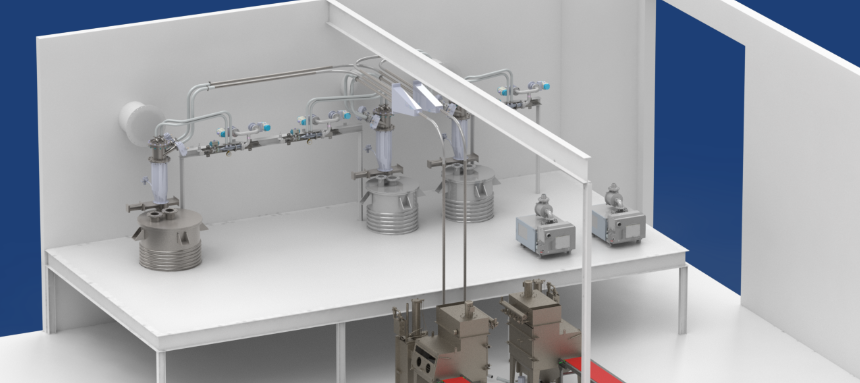Pneumatic Conveying of Solids - Dense Phase vs. Dilute Phase Transfer
 Historically, pneumatic conveying systems have been separated into two basic categories, dense phase and dilute phase type systems. While there is no one specific operating criterium that clearly differentiates the two, there are several design considerations and operating parameters that are generally used to classify a specific system as one type or the other. In this blog post we’ll provide a basic overview of some of those system designs and discuss some operating advantages and issues related to solids flow patterns and conveying distances.
Historically, pneumatic conveying systems have been separated into two basic categories, dense phase and dilute phase type systems. While there is no one specific operating criterium that clearly differentiates the two, there are several design considerations and operating parameters that are generally used to classify a specific system as one type or the other. In this blog post we’ll provide a basic overview of some of those system designs and discuss some operating advantages and issues related to solids flow patterns and conveying distances.
Solids Flow Patterns
Dilute Phase Systems
Almost any material can be conveyed in dilute phase fashion. It is simply a matter of accelerating the conveying gas stream to a velocity where all the material particles are picked up, suspended, and remain so as they are carried along with it. This gas velocity is termed the “saltation velocity” of the material, and it is determined primarily by the size, shape and density of the solid particles.
Dilute phase systems typically have a gas stream velocity of 4,000 – 6,000 ft. / min. and a solid loading ratio in the gas stream of no more than 15 lbs. of solid / lb. of conveying gas. If the velocity of the gas stream falls below the material’s saltation velocity, some particles will begin to drop out of suspension, but will likely still be swept along the bottom of the conveying line due to friction with the gas stream and particles that remain suspended in it. This condition is termed dilute phase “strand flow” and represents the beginning of the transition from dilute to dense phase conveying.

Dilute Phase
Gas velocity v = 4,000 – 6,000 ft/min
Solids Velocity c = 3,000 – 5,000 ft/min

Dilute Phase – Strand Flow
Gas Velocity v = 3,000 – 5,000 ft/min
Solids Velocity c = 2,000 – 4,000 ft/min
Dense Phase Systems
Dense phase transfer generally occurs in one of two basic forms, plug flow or moving bed (dune) flow. During plug flow, solids fully fill the conveying line and move along with gaps of air between individual plugs. During moving bed (dune) flow, material is carried along in individual waves that sweep over the bed of particles that are also moving along the bottom of the conveying line.
Which form of dense phase transfer occurs depends primarily on specific properties of the solid, namely its ability to be fluidized (i.e., its level of gas permeability and air retention), its particle size-distribution and its particle shape(s).

Dense Phase – Plug Flow
Gas Velocity v = 600 – 1,000 ft/min
Solids Velocity c = 20 – 200 ft/min

Dense Phase – Dune Flow
Gas Velocity v = 800 – 2,500 ft/min
Solids Velocity c = 40 – 400 ft/min
Dense phase systems typically have a maximum gas stream velocity of 2,500 ft. / min. and solids loading ratio of 20 - 150 lbs. of solid / lb. of conveying gas.
Conveying Distances
Dilute Phase Systems
The primary factor that determines the distance a pneumatic conveying system can transfer a specific material is the pressure drop required to convey it from its initial pick-up point in the conveying line to its discharge point.
Since pressure drop is directly related to a system’s conveying line length and solids loading ratio, most long distance conveying is done using dilute phase systems, and the conveying gas pressure is typically between 15 – 100 psig.
One limiting factor for the gas supply pressure is the fact that the gas’ pressure will drop as it moves along the conveying line. This reduction in pressure will allow the gas to expand and thus increase in velocity according to (Q=VA). If the conveying gas flow (Q) remains constant, and the line has a fixed area (A - read “diameter”), the increasing gas velocity will result in an increasing pressure drop that is proportional to the velocity squared (V2). For this reason, it is often necessary to increase the conveying line diameter in steps along its path to maintain a relatively constant velocity (read pressure drop) in long-distance transfer applications.
It is worth noting that the conveying line’s length must be calculated using the “equivalent length” of elbows and vertical rises because these will have a significantly higher relative length (up to 40-60X) than that of a single foot of horizontal line length.
Dense Phase Systems
While most dilute phase system operate using positive pressure gas, dense phase systems can operate under either vacuum or positive pressure (although usually at lower positive pressures than dilute phase systems).
Materials with relatively large particle size and a narrow particle size distribution typically have good air permeability characteristics and will convey well in dense phase plug flow. Conversely, powdered materials with small particle sizes such as flour or fly-ash have good air-retention properties and will typically move along the conveying line as a fluidized mass and convey well in moving bed fashion.
A quick and simple test to determine if a material has a good air retention or permeability property is to shake a closed sample jar of the material to aerate it and then remove the lid and drop a small ball bearing into it. If the ball bearing falls through the sample to the bottom of the jar, it demonstrates good air retention and it will likely transfer well in dense phase, moving bed fashion. If the ball bearing does not penetrate the material very far, then it is an indication it has good air permeability property and will convey well in dense phase, plug flow fashion. However, only transfer testing of the material is likely to provide proof of its ability to be pneumatically transferred in dense phase fashion.
Here's a video demonstrating dense phase transfer in a test we recently performed for a client at our test center:
Making a Choice
The capabilities of pneumatic conveying systems are extremely diverse since almost any dry solid can be conveyed long distances at relatively high flow rates in either dilute or dense phase fashion. And while the compressibility of the conveying gas will present some practical limitations, other economic factors such as actual application requirements, power consumption and capital costs will likely be the determining factors as to whether a dilute or dense phase system is right for your specific application. To learn more about dilute phase and dense phase methods of transfer and how they compare to other conveying methods, download our Comparison Guide on Pneumatic Conveying vs. Mechanical Conveying.
